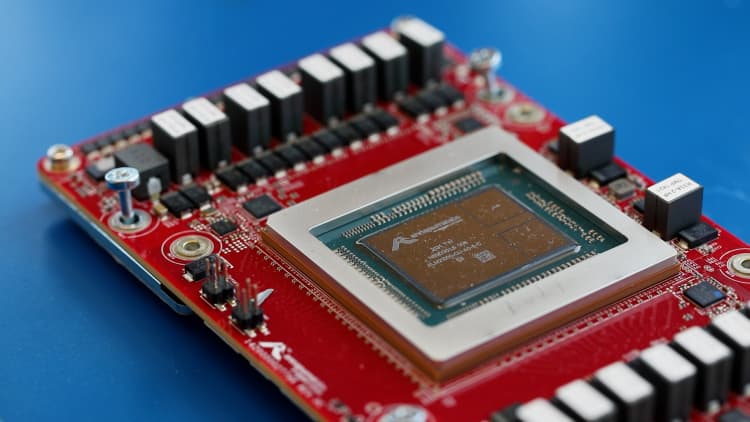
Jensen Huang, co-founder and chief executive officer of Nvidia Corp., during the Nvidia GPU Technology Conference (GTC) in San Jose, California, US, on Tuesday, March 19, 2024.
David Paul Morris | Bloomberg | Getty Images
Nvidia’s 27% rally in May pushed its market cap to $2.7 trillion, behind only Microsoft and Apple among the most-valuable public companies in the world. The chipmaker reported a tripling in year-over-year sales for the third straight quarter driven by soaring demand for its artificial intelligence processors.
Mizuho Securities estimates that Nvidia controls between 70% and 95% of the market for AI chips used for training and deploying models like OpenAI’s GPT. Underscoring Nvidia’s pricing power is a 78% gross margin, a stunningly high number for a hardware company that has to manufacture and ship physical products.
Rival chipmakers Intel and Advanced Micro Devices reported gross margins in the latest quarter of 41% and 47%, respectively.
Nvidia’s position in the AI chip market has been described as a moat by some experts. Its flagship AI graphics processing units (GPUs), such as the H100, coupled with the company’s CUDA software led to such a head start on the competition that switching to an alternative can seem almost unthinkable.
Still, Nvidia CEO Jensen Huang, whose net worth has swelled from $3 billion to about $90 billion in the past five years, has said he’s “worried and concerned” about his 31-year-old company losing its edge. He acknowledged at a conference late last year that there are many powerful competitors on the rise.
“I don’t think people are trying to put me out of business,” Huang said in November. “I probably know they’re trying to, so that’s different.”
Nvidia has committed to releasing a new AI chip architecture every year, rather than every other year as was the case historically, and to putting out new software that could more deeply entrench its chips in AI software.
But Nvidia’s GPU isn’t alone in being able to run the complex math that underpins generative AI. If less powerful chips can do the same work, Huang might be justifiably paranoid.
The transition from training AI models to what’s called inference — or deploying the models — could also give companies an opportunity to replace Nvidia’s GPUs, especially if they’re less expensive to buy and run. Nvidia’s flagship chip costs roughly $30,000 or more, giving customers plenty of incentive to seek alternatives.
“Nvidia would love to have 100% of it, but customers would not love for Nvidia to have 100% of it,” said Sid Sheth, co-founder of aspiring rival D-Matrix. “It’s just too big of an opportunity. It would be too unhealthy if any one company took all of it.”
Founded in 2019, D-Matrix plans to release a semiconductor card for servers later this year that aims to reduce the cost and latency of running AI models. The company raised $110 million in September.
In addition to D-Matrix, companies ranging from multinational corporations to nascent startups are fighting for a slice of the AI chip market that could reach $400 billion in annual sales in the next five years, according to market analysts and AMD. Nvidia has generated about $80 billion in revenue over the past four quarters, and Bank of America estimates the company sold $34.5 billion in AI chips last year.
Many companies taking on Nvidia’s GPUs are betting that a different architecture or certain trade-offs could produce a better chip for particular tasks. Device makers are also developing technology that could end up doing a lot of the computing for AI that’s currently taking place in large GPU-based clusters in the cloud.
“Nobody can deny that today Nvidia is the hardware you want to train and run AI models,” Fernando Vidal, co-founder of 3Fourteen Research, told CNBC. “But there’s been incremental progress in leveling the playing field, from hyperscalers working on their own chips, to even little startups, designing their own silicon.”
AMD CEO Lisa Su wants investors to believe there’s plenty of room for many successful companies in the space.
“The key is that there are a lot of options there,” Su told reporters in December, when her company launched its most recent AI chip. “I think we’re going to see a situation where there’s not only one solution, there will be multiple solutions.”
Other big chipmakers
Lisa Su displays an AMD Instinct MI300 chip as she delivers a keynote address at CES 2023 in Las Vegas, Nevada, on Jan. 4, 2023.
David Becker | Getty Images
AMD makes GPUs for gaming and, like Nvidia, is adapting them for AI inside of data centers. Its flagship chip is the Instinct MI300X. Microsoft has already bought AMD processors, offering access to them through its Azure cloud.
At launch, Su highlighted the chip’s excellence at inference, as opposed to competing with Nvidia for training. Last week, Microsoft said it was using AMD Instinct GPUs to serve its Copilot models. Morgan Stanley analysts took the news as a sign that AMD’s AI chip sales could surpass $4 billion this year, the company’s public target.
Intel, which was surpassed by Nvidia last year in terms of revenue, is also trying to establish a presence in AI. The company recently announced the third version of its AI accelerator, Gaudi 3. This time Intel compared it directly to the competition, describing it as a more cost-effective alternative and better than Nvidia’s H100 in terms of running inference, while faster at training models.
Bank of America analysts estimated recently that Intel will have less than 1% of the AI chip market this year. Intel says it has a $2 billion order of backlogs for the chip.
The main roadblock to broader adoption may be software. AMD and Intel are both participating in a big industry group called the UXL foundation, which includes Google, that’s working to create free alternatives to Nvidia’s CUDA for controlling hardware for AI applications.
Nvidia’s top customers
One potential challenge for Nvidia is that it’s competing against some of its biggest customers. Cloud providers including Google, Microsoft and Amazon are all building processors for internal use. The Big Tech three, plus Oracle, make up over 40% of Nvidia’s revenue.
Amazon introduced its own AI-oriented chips in 2018, under the Inferentia brand name. Inferentia is now on its second version. In 2021, Amazon Web Services debuted Tranium targeted to training. Customers can’t buy the chips but they can rent systems through AWS, which markets the chips as more cost efficient than Nvidia’s.
Google is perhaps the cloud provider most committed to its own silicon. The company has been using what it calls Tensor Processing Units (TPUs) since 2015 to train and deploy AI models. In May, Google announced the sixth version of its chip, Trillium, which the company said was used to develop its models, including Gemini and Imagen.
Google also uses Nvidia chips and offers them through its cloud.
Microsoft isn’t as far along. The company said last year that it was building its own AI accelerator and processor, called Maia and Cobalt.
Meta isn’t a cloud provider, but the company needs massive amounts of computing power to run its software and website and to serve ads. While the Facebook parent company is buying billions of dollars worth of Nvidia processors, it said in April that some of its homegrown chips were already in data centers and enabled “greater efficiency” compared to GPUs.
JPMorgan analysts estimated in May that the market for building custom chips for big cloud providers could be worth as much as $30 billion, with potential growth of 20% per year.
Startups
Cerebras’ WSE-3 chip is one example of new silicon from upstarts designed to run and train artificial intelligence.
Cerebras Systems
Venture capitalists see opportunities for emerging companies to jump into the game. They invested $6 billion in AI semiconductor companies in 2023, up slightly from $5.7 billion a year earlier, according to data from PitchBook.
It’s a tough area for startups as semiconductors are expensive to design, develop and manufacture. But there are opportunities for differentiation.
For Cerebras Systems, an AI chipmaker in Silicon Valley, the focus is on basic operations and bottlenecks for AI, versus the more general purpose nature of a GPU. The company was founded in 2015 and was valued at $4 billion during its most recent fundraising, according to Bloomberg.
The Cerebras chip, WSE-2, puts GPU capabilities as well as central processing and additional memory into a single device, which is better for training large models, said CEO Andrew Feldman.
“We use a giant chip, they use a lot of little chips,” Feldman said. “They’ve got challenges of moving data around, we don’t.”
Feldman said his company, which counts Mayo Clinic, GlaxoSmithKline, and the U.S. Military as clients, is winning business for its supercomputing systems even going up against Nvidia.
“There’s ample competition and I think that’s healthy for the ecosystem,” Feldman said.
Sheth from D-Matrix said his company plans to release a card with its chiplet later this year that will allow for more computation in memory, as opposed to on a chip like a GPU. D-Matrix’s product can be slotted into an AI server along existing GPUs, but it takes work off of Nvidia chips, and helps to lower the cost of generative AI.
Customers “are very receptive and very incentivized to enable a new solution to come to market,” Sheth said.
Apple and Qualcomm
Apple iPhone 15 series devices are displayed for sale at The Grove Apple retail store on release day in Los Angeles, California, on September 22, 2023.
Patrick T. Fallon | Afp | Getty Images
The biggest threat to Nvidia’s data center business may be a change in where processing happens.
Developers are increasingly betting that AI work will move from server farms to the laptops, PCs and phones we own.
Big models like the ones developed by OpenAI require massive clusters of powerful GPUs for inference, but companies like Apple and Microsoft are developing “small models” that require less power and data and can run on a battery-powered device. They may not be as skilled as the latest version of ChatGPT, but there are other applications they perform, such as summarizing text or visual search.
Apple and Qualcomm are updating their chips to run AI more efficiently, adding specialized sections for AI models called neural processors, which can have privacy and speed advantages.
Qualcomm recently announced a PC chip that will allow laptops to run Microsoft AI services on the device. The company has also invested in a number of chipmakers making lower-power processors to run AI algorithms outside of a smartphone or laptop.
Apple has been marketing its latest laptops and tablets as optimized for AI because of the neural engine on its chips. At its upcoming developer conference, Apple is planning to show off a slew of new AI features, likely running on the company’s iPhone-powering silicon.

